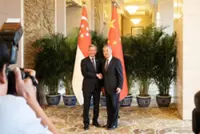Typhoon Gaemi, which lashed the Philippines, Taiwan and southern China in late July, signalled what is to come as a warming climate speeds up the formation of catastrophic storms and shifts their pathways towards the north.
The third named storm and second typhoon of the annual typhoon season, Gaemi killed dozens as it wreaked untold damage in its path.
As the world warms, typhoons in South-East Asia are expected to intensify more quickly, move northwards towards places such as China and the Korean peninsula, and slow down on land – causing more damage in highly populated coastal areas and beyond.
Typhoon modelling studies done by researchers at the Nanyang Technological University (NTU) and two United States institutes also found that coastal cities such as Bangkok, Yangon and Hai Phong in Vietnam are likely to bear the brunt of these longer-lasting and more powerful cyclones.
Professor Benjamin Horton, director of NTU’s Earth Observatory of Singapore (EOS) and a co-author of the study, said: “As our waters gain more temperature, tropical cyclones are going to start to occur in regions that previously didn’t have them much.
“South-East Asia has a high frequency of tropical cyclones, but what we noticed is that the South China Sea is going to get hotter and hotter. So you’re going to start to get tropical cyclones farther northwards along the China coast and South Korea more frequently.”
In both medium and high greenhouse gas emission scenarios, the researchers’ models found that increasingly, typhoons will form over the South China Sea and make landfall north.
Currently, most typhoons brew over the Western Pacific, which includes the waters east of the Philippines, said Dr Dhrubajyoti Samanta, senior research fellow at EOS and another co-author of the study.
On whether this could mean fewer typhoons for the Philippines in the future, Dr Samanta said: “It could be reduced compared with what they are facing today, but that does not mean that the Philippines will be free from cyclones.
Fewer, but more high-magnitude ones, can be damaging.
“Cyclones originating nearby or at the South China Sea can also hit the Philippines.”
The Philippines is often considered “cyclone central”, with about 20 storms and typhoons slamming into the archipelago every year. Particularly destructive were Super Typhoon Haiyan in 2013 and Typhoon Rai in 2021.
The researchers predict more storms in the future could take a path like Typhoon Gaemi’s.
While the typhoon did not make landfall in the Philippines, it intensified the south-west monsoon, bringing relentless rain and floods to Manila and northern provinces around July 24.
The South-East Asia typhoon study also involved researchers from Rowan University in New Jersey and the University of Pennsylvania.
The scientists worked with more than 64,000 simulated tropical cyclones from the 19th century to the end of the 21st century, under both moderate and high carbon emissions scenarios. This was done with the help of Professor Kerry Emanuel, an atmospheric science expert from the Massachusetts Institute of Technology.
The simulations showed changes in where cyclones form, strengthen, slow down and eventually decay.
The scientists’ typhoon predictions for South-East Asia were published in the journal Climate and Atmospheric Science in early July. — The Straits Times/ANN





